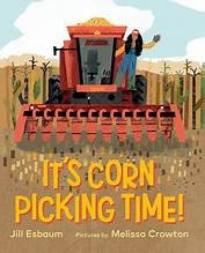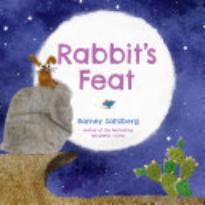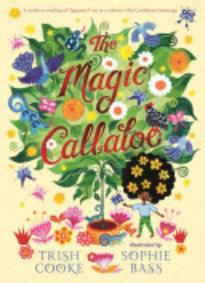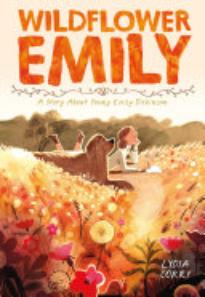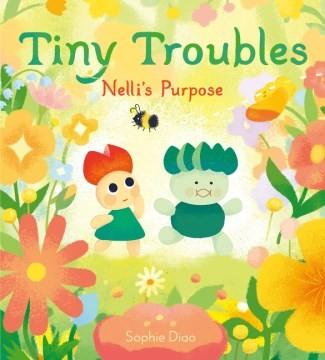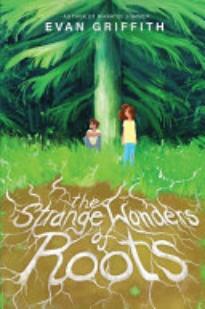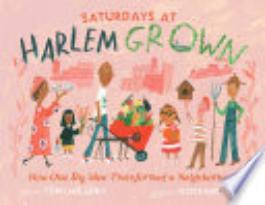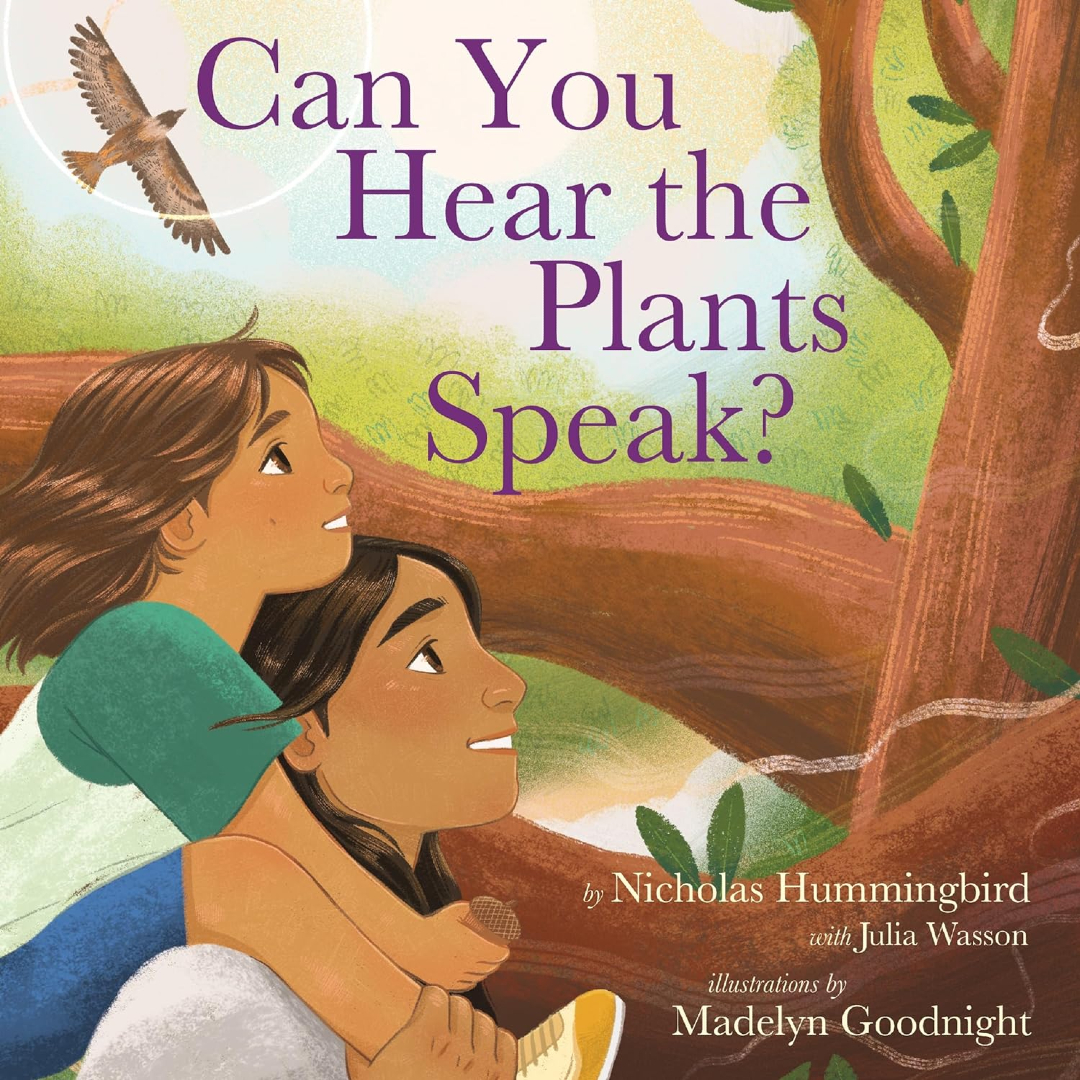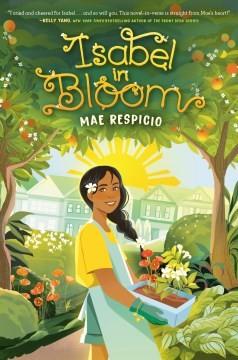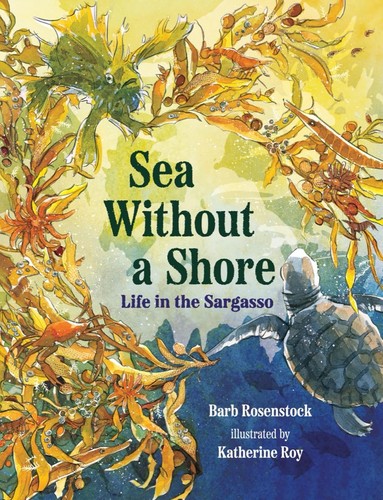Plants
374 Reviews
(2)
K-3
Illustrated by
Melissa Crowton.
Before the sun rises, a farmer gets the combine from the shed, gathers tools for the day, and begins the task at hand: picking corn (which an endnote clarifies is not the sweet corn we eat). Patterned text introduces readers to the parts of the combine and other elements of the corn-picking process. First the “autumn-dry stalks” shuttle through the cornhead and into the grain tank, while the spreader scatters chaff being “spit out the back.” The corn then moves from the combine to a grain wagon, transporting the kernels to the dryer, which sends out a “steamy, roast-corn-scented cloud.” Esbaum’s well-crafted rhyme carries the corn from field to bin with every accompanying sight, sound, and smell. Crowton’s warm, inviting illustrations in an autumnal palette help both to convey the information and to humanize the work. Back matter with interspersed spot art provides additional information about the process of harvesting this late-season crop and the many ways it is used; further reading and related websites are also appended. An informative and playful ode to agriculture.
(2)
K-3
"Every spring, Rabbit heard Boulder and Cactus having the same conversation." Boulder, perched near the edge of a small cliff, longs to see Cactus's nighttime-blooming flowers up close. "Today will be the day...I'm coming over there!" Cactus is down below, a stone's throw from the bottom of the cliff. (Despite being depicted realistically without any facial features, both Boulder and Cactus can speak and see, adding to the humor.) Rabbit and a butterfly friend have nonspeaking roles (and go unnoticed by the two other characters), but they are instrumental in helping Boulder realize the dream—something young listeners will easily pick up on in Saltzberg's appealingly textured digital illustrations. Throughout the day, Rabbit makes attempts to move the immovable as Boulder and Cactus converse optimistically. Finally, under a full moon and with the flowers on the verge of blooming, eight rabbits stand at one end of a homemade lever, not quite able to roll Boulder over the edge. Saltzberg slows things down: over three panels and one double-page spread, the butterfly flits over to the stack of rabbits, softly alighting on Rabbit's ear. "Sometimes, thought Rabbit...with...a little...help...and a little kindness..." and with the addition of one butterfly: "BOOM!" Boulder sticks the landing, and Saltzberg does too.
Reviewer: Kitty Flynn
| Horn Book Magazine Issue:
July, 2025
(3)
K-3
Illustrated by
Adriana Predoi.
Haunted by rejection after moving through seven foster homes, a boy named Lamar resists his new foster mother’s invitations to garden together, until curiosity draws him outside. As they plant and care for flowers, Lamar’s guarded heart begins to open. The digital-looking illustrations depict these Black characters with warmth. The text introduces concepts like seedlings, perennials, and annuals, connecting gardening to personal growth. A moving tale of resilience, emotional healing, and belonging.
Reviewer: Summer Edward
(2)
K-3
Illustrated by
Jenn Ely.
This picture-book biography introduces young readers to the conservation efforts of Hoyt, focusing mainly on her life after the death of her husband in 1918. Newly married in 1897, they had moved to Pasadena, California, where it was only a matter of time before she fell in love with the Mojave Desert. She was particularly interested in Joshua trees, which are not trees at all but rather the largest member of the yucca plant family. By 1933, the Joshua trees and their habitat were threatened by carelessness (people cut them down for wood), and Hoyt hatched a plan to designate the area as a national park, preserving this unique ecosystem. It was a hard sell, but she -- and the activists she inspired -- were ultimately successful. "No one who heard her talk could ever again regard the subject of conservation of desert flora with indifference," said a fellow environmentalist. Ely's cozy gouache illustrations (double-page spreads, single-page drawings, and spot art) depict both Hoyt's plucky spirit and the majesty of the high desert landscape. More information about Hoyt and Joshua Tree National Park, along with tips for environmental activists, photographs, an author's note, and a select bibliography, are appended.
Reviewer: Jonathan Hunt
| Horn Book Magazine Issue:
January, 2024
(3)
K-3
Illustrated by
Sophie Bass.
Lou, a girl born from a wish on the leaves of a magical callaloo plant, is kidnapped by a wicked man. He forces her to do manual labor and cuts her magical hair short, though it always grows back “thicker and longer than before.” When a wise woman visits and braids Lou’s hair, she also gives Lou an escape route. Intricate, brilliant gouache illustrations bring this inventive story to life; an author’s note explains that the story is inspired by Rapunzel and tales of enslaved people’s use of cornrow braid patterns as maps to freedom.
Reviewer: Rachel L. Kerns
(2)
4-6
Corry introduces readers to the young Emily Dickinson (1830–1886) in creative graphic-novel form. "One day Emily would become known as one of the greatest poets who ever lived!" But this is not that story; instead, it is a glimpse of some of the things that helped shape her future as a poet. We learn that she loved studying botany in school and created her own herbarium, gathering plant specimens on her "wildflower walks" with her dog, Carlo ("my shaggy ally"). Most of the book imagines one such walk to "meet the flowers." Throughout, Corry incorporates Dickinson's own words in speech bubbles as well as a selection of her poems. Watercolor, gouache, and colored-pencil illustrations reflect Emily's internal transformation as color transitions from shades of sepia for the school and home scenes to full color as she embarks on her walk. The illustrations also playfully highlight Emily's imagination at work, as insects play instruments, sail the sea, have tea, and more; when she briefly loses track of Carlo in the woods, Emily fearfully envisions what could have happened ("What if...goblins have kidnapped him?"). The varied panel layout is easy to follow, adds momentum, and reflects Emily's passionate and detailed nature. While Corry admits to taking artistic license with the timeline, the book gives readers a sense of Dickinson without overwhelming them with facts. Back matter includes additional biographical information and suggestions for further reading.
Reviewer: Cynthia K. Ritter
| Horn Book Magazine Issue:
January, 2025
(2)
K-3
Illustrated by
Emily Sutton.
Davies showcases the important role that plants play on Earth as consumers of carbon, producers of oxygen, and mitigators of the effects of human-induced global warming. The meaning of "green" is creatively expanded from the color we associate with plants to encompass the process of photosynthesis and the components of plant cells in which it takes place. "Their green isn't just a color...this green catches the energy in sunlight." Sutton's lush illustrations, naturally featuring many shades of green, fill the pages with tendrils, roots, and leaves at macro and micro scales and portray ecosystems on land and water throughout Earth's history as teeming with plants and animals. As Davies explains the history of plant life and its transformation into today's fossil fuels, the story shifts into how human exploitation of ancient life has meant the release of too much carbon dioxide into our atmosphere. Luckily, today's green plants in the sea and across various environments fight back against climate change. We must "remember that GREEN is the most important color in the world."
Reviewer: Danielle J. Ford
| Horn Book Magazine Issue:
January, 2024
(2)
K-3
Two succulent-looking sentient plants search for meaning in this philosophical picture book. Easygoing Worthi seems content with life, but Nelli is restless and wonders about finding one's purpose: "I heard it gives you strength when life gets tough." Worthi drags Nelli into the forest to look for answers. The friends try to contemplate (and not be overwhelmed by) the scale of either the concepts they're considering or the natural world they explore, with amusing results: a purpose is satisfying and comforting, but it is not a baked potato. The pair then meets a charming cast of mindfulness-centered characters introduced one by one with a steady, rhythmic pace. A frog stuck in a spiderweb questions goodness; a meditative stinkbug encourages looking within; and a bee endorses following one's heart. The dialogue-only text is full of care and curiosity, with scaffolding for readers new to the comics format provided by color-coded speech balloons and lots of white space. The digital illustrations have a dreamlike texture to them, with fuzzy, misty edges and jeweled hues. When the day is through, the tiny plants haven't found any answers, but they enjoyed the journey and look forward to continuing their quest and thinking more tomorrow.
Reviewer: Elisa Gall
| Horn Book Magazine Issue:
May, 2024
(2)
K-3
Illustrated by
Susie Ghahremani.
Memory and connections with the "old country" can be important parts of the experience for immigrant families. In this story, a young girl helps her Iranian (as identified in the back matter) grandmother, Nana, tend her garden, while relishing "the stories she tells me about a garden she knows far away." As the two plant and water geraniums, Nana shares tales of "back home," even though the girl doesn't "know where 'back home' is." There were tall cypress trees, fragrant jasmine, lilac, and hyacinth; there was a fishpond, and fruit trees including cherry, mulberry, and pomegranate. Gouache illustrations on vellum represent a modest Western garden in contrast with the lusher, bursting garden of Nana's memories on the facing page. Paisley, floral, and other distinctly traditional Persian designs adorn the pages in saffron yellows, minty greens, and radish-y reds. These embellishments make a visual connection between Nana's new home and her "back home" memories; the book's playful endpapers also capture this design aesthetic. In this gentle tale, stories are like plants that grow in the girl's imagination, taking root to bloom into cultural pride and intergenerational connection. Author and illustrator notes discuss the importance of gardens for many Iranians as well as the importance of cultural transmission.
Reviewer: Julie Hakim Azzam
| Horn Book Magazine Issue:
March, 2024
(2)
4-6
In the five years since her parents divorced, twelve-year-old Holly has lived in and visited lots of places with her actor father; she is used to not feeling rooted in any one spot. Now her father has flown off to San Francisco for his "big break" in A Midsummer Night's Dream while Holly goes to Burlington, Vermont, "a city she'd never heard of in a state she'd never been to," to stay with her uncle Vincent for a month. Holly hasn't seen him since three Christmases ago, but she remembers a lot about him: he's gay; is a year younger than her father; lives alone in a small town outside Burlington; and runs a bookstore, where he is "drowning in books." The beautiful cover illustration and even Holly's name refer to her love of plants, and the metaphor will not be lost on readers: Holly yearns for roots in her life, and Uncle Vincent and his community just might be the ones to help. And, sure enough, she does find much of what she's looking for. Holly is a well-drawn, likable protagonist dropped into a New England setting, where she thrives. A gentle, uplifting, and memorable story.
Reviewer: Dean Schneider
| Horn Book Magazine Issue:
July, 2024
(2)
K-3
Illustrated by
Jessie Hartland.
Mr. Tony and his student, Nevaeh, plot during the winter months how to bring their community garden in Harlem into bloom with a spring cleanup and planting party. The nei7ghborhood shows up -- people of all backgrounds, with gardening tools and flowers and seeds and doughnuts for snacking on -- to work together and watch their garden grow. They add a small library, too, and just as they share their library of books, the group shares their library of knowledge, with members who have expertise in cooking, in raising chickens, in plumbing and carpentry. Hartland's illustrations burst with color and detail, a visual feast; keen-eyed readers will notice plants growing and changing from scene to scene. The daubs of paint and visible brushstrokes give the art a tactile feel that pairs well with the vibrancy and hands-on nature of the garden. Children will enjoy the art but also likely appreciate learning (from the back matter) that the book is based on a true story and written by Mr. Tony himself. Steps to start an urban school community garden and a recipe for vegetable soup are also appended. Perfect both for a lap-sit to pore over the details and for community-garden or farmers' market storytimes.
(3)
K-3
Illustrated by
Madelyn Goodnight.
A Native boy learns about the kinship between plants and humankind from his great-grandparents before his people's untouched lands are destroyed for urban development. He loses his “connection to spirit” as he grows older until a lone city flower inspires him to keep the voices of his human and plant relatives alive. Hummingbird's (Cahuilla/Apache) autobiographical account of his journey to becoming a Native plant expert/activist balances pathos and ethos, bolstered by Goodnight's (Chickasaw) gentle illustrations. Back matter includes plant conservation tips and further reading.
Reviewer: Summer Edward
(2)
PS
Brushy watercolors in sunny pastel tones illustrate a meditation on change in the form of a paean to the daylily. Raschka's big blue text (which looks hand-lettered) guides readers through the rhyme: "Monday's lily / blooms // for the baby. // Tuesday's lily blooms / for the cat. // Wednesday's lily blooms for Mommy. / Thursday's lily blooms // just like that." Each double-page spread zooms in on a lily in bloom; viewers will notice that yesterday's shriveled-up blossom droops from a different stem in nearly every composition, emphasizing the flowers' evanescence. Bugs, rabbits (one "the baby," the other "Mommy"), a gray tabby, a turtle, and other critters happily explore the greenery surrounding the lilies. In structure and rhythm, Raschka's verse recalls the nursery rhyme "Monday's Child," but its intent is far lighter (nobody is "full of woe" here) and less deterministic. "Sunday's lily blooms for her and him," we learn, and "Tomorrow's lily blooms for them"; readers are free to interpret this in multiple ways, including as an affirmation of gender diversity. Likewise, lines that address lilies' mortality do not dwell on death but touch on coming and going, and on lasting memories. Even as the verses' focus expands, the illustrations never lose their gentle sweetness, with the bugs, ants, and butterflies that inhabit this garden providing visual counterpoint. Whether read literally or metaphorically, this lilting ode gifts little ones a dollop of seasonal sunlight.
Reviewer: Vicky Smith
| Horn Book Magazine Issue:
January, 2024
(2)
4-6
In this verse novel set in 1999, twelve-year-old Isabel Ligaya leaves her home in the Philippines to reunite with her mother in California. Mama immigrated to the U.S. five years ago to work as a nanny, and Isabel is eager to see her but nervous about leaving her grandparents, her friends, and her beloved sampaguita (jasmine) plant. Having grown up with grandparents who sell vegetables at the market, Isabel is familiar with tending a garden, but the transition to growing a life in the U.S. has challenges. She's self-conscious about her accent, finds making new friends daunting, and is disappointed that Mama spends most of her time looking for a job. Over the course of a year, Isabel discovers what can grow when one nourishes a seed with tenacity, love, and friendship. Respicio conveys Isabel's experience mostly through accessible free verse and narrative poetry, and includes acrostic, haiku, palindrome, tanaga (an indigenous form of Filipino poetry), and concrete poems. The novel brings light to unconventional family structures and hate crimes against Asian Americans elders. An author's note discusses the poetic forms and imagery, as well as the experiences of Asian Americans today.
Reviewer: Gabi K. Huesca
| Horn Book Magazine Issue:
July, 2024
(2)
K-3
Illustrated by
Katherine Roy.
The Sargasso Sea sits within the Atlantic Ocean and is home to an ecosystem centered on the seaweed genus Sargassum. To the children portrayed exploring the seashore in the opening pages (and to readers), Sargassum may look like a plant, but it is actually algae and has intriguing characteristics. The large clumps of Sargassum that float on the water and reproduce by fragmentation host a diverse array of life. Rosenstock moves across the region's food web from the tiny to the large, beginning with microscopic life ("Crusty bryozoans / Feathery hydroids / Spiraled tube worms") and continuing through mollusks and crustaceans to the largest fish and whales. The text is dense with descriptive words, poetic phrasing, and scientific details: "The frogfish creeps. Hanging by fingery fins. Luring in prey, darting out to swallow it whole." A repeated phrase with slight variations at the end of each section connects each species back to its seaweed host. Roy's lush illustrations, set in clear, deep blue waters, bring it all to life. Featured species live, hunt, and reproduce within the swirling ocher of the Sargassum fronds, while white speckles of nutrients drift by. Back matter includes a helpful map and key to major Sargasso Sea species, an afterword by marine biologist Dr. Sylvia Earle, considerations of threats from climate change, and an account of the author and illustrator's travels to Bermuda to see the Sargasso Sea and consult with oceanographers.
Reviewer: Danielle J. Ford
| Horn Book Magazine Issue:
November, 2024
(2)
K-3
Nature walks and gardening result in an introspective child thinking small (and big) thoughts about the natural world in this quiet, poetic account, effectively told in the first person. The narrator's sister, experienced and knowledgeable about many things leafy and blossoming, makes grand statements about the plants and flowers they encounter. "Magnolias smell like lemon cake," she announces, causing her sibling self-doubt because "they just smell like flowers to me." Her confident observations about quince trees, dandelions, and maple saplings have the narrator wondering how she knows so much, while our protagonist cannot grasp the complexities of goutweed or even name the big tree outside the window. Wong deftly plays with perspective throughout, often showing the children from overhead as they walk through the woods or pull weeds in the garden. Heavy on greens, his pastel paintings have a serene, hazy feel, evoking the season of spring. One striking sequence shows the child lying in bed at night, looking with curiosity out the window at the sparkling stars in the sky. Wong brings the action to a satisfying close when the child finds a plant that even confounds the older sister. They will look it up in one of her books, after they tend to the garden. This book emerges as both a celebration of nature and of a loving sibling bond.
(2)
K-3
Propelled by the wind, a dry, brown tumbleweed named Tumble travels across the desert, its journey depicted by a series of dotted lines reminiscent of the bouncing ball following words in a song. Short, direct sentences on each double-page spread describe the action: "Wind blows. / Tumble goes. / Fence stops. / Tumble hops." Full-bleed, bold-hued illustrations mirror the text and add native animals (such as a collared lizard) and plants (a mesquite tree) that appear along the way. "Tumble goes and goes and goes," until a cactus impedes its progress. There, the protagonist stays for several days. Rain falls; Tumble puts down roots, turns green, blooms, and dries out, carrying its seeds as the wind again blows it across the desert. An appended double-page spread identifies the plants and animals, asking youngsters to spot them in the text and subtly reinforcing that reading is an active process. The book concludes with additional facts about tumbleweeds; a diagram of a tumbleweed's life cycle may need adult clarification, since the narrative begins in the middle of the cycle. The book begs for a group read-aloud that allows youngsters to re-create Tumble's hopping, going, stopping, and staying.
Reviewer: Betty Carter
| Horn Book Magazine Issue:
September, 2023
(2)
4-6
Raised by her two papas on a remote island (the setting is loosely based on the Azores), Henna has a gift for plants, so when she learns her papa Niall has incurable cancer, she vows to save him using her plant knowledge. Tales of a nearly extinct specimen with miraculous healing powers, the nightwalker, send her off-island to St. Basil's, the botanical secondary school where a nightwalker seed is rumored to be stored in a secret repository. Henna and another student who calls themself P are both admitted on scholarship, with the requirement that they act in service to fellow new student Lora, the wheelchair-using daughter of the exorbitantly wealthy Windover family. At first standoffish, Lora confides her desire to do more things for herself and later provides help when Henna and P's efforts to find the seed land them in trouble. Issues of disability accessibility, gender identity, and grief and loss figure heavily, yet naturally, in the intertwined storylines. Dairman evokes a Victorian plant-hunter aesthetic while skirting the border of fantasy (the nightwalker is described in magical terms as able to "walk" up the trunk of its host plant, the orange tree), although the affecting ending lands the book squarely in realism. Readers intrigued by the wonders of the natural world will find a kindred spirit in Henna, whose determination and unwavering love for her papas propel this story to its dynamic conclusion.
Reviewer: Anita L. Burkam
| Horn Book Magazine Issue:
March, 2023
 Harrington, Janice N.
Taylor III, Theodore, Illustrator
Harrington, Janice N.
Taylor III, Theodore, Illustrator
Rooting for Plants: The Unstoppable Charles S. Parker, Black Botanist and Collector
(2)
K-3
Harrington and Taylor (Buzzing with Questions, rev. 11/19) introduce the life of another pioneering Black scientist, Charles S. Parker (1882–1950). Clear, engaging prose outlines Parker's lifelong love of plants, his desire to know "where, when, why, and how they grew," and to help others "learn to love plants, too." Parker not only made his mark locating, collecting, and identifying plant and fungi specimens, he also served as a mentor to Black scholars, particularly women who were underrepresented in the academic world. Clearly, that desire to help others guided him: as a young man he co-founded a newspaper focusing on jobs for Black workers and, as a First Lieutenant in WWI, petitioned for equality for Black soldiers. After the war, Parker's research began in earnest as he collected plants across the U.S. and Canada, devised a process for preserving them, and pioneered work in mushrooms and other fungi. With an appropriately earth-toned palette, Taylor's digital art spotlights Parker's collection expeditions, the plants and fungi he studied, and his fieldwork with students. Appended with a scientific glossary; additional biographical information about Parker; a timeline of his life; brief biographies of six notable Black scientists (three of whom he mentored); and extensive bibliographic material.
Reviewer: Betty Carter
| Horn Book Magazine Issue:
July, 2023
(2)
K-3
Illustrated by
Ishita Jain.
In 1979 in remote northeastern India, sixteen-year-old Jadav Payeng is troubled by the way the river "goes wild" during monsoon season: it overflows, ravages islands, and decimates wildlife. Young Jadav proposes to plant trees on sandbars and islands as a way to anchor the soil against the river's raging currents. He starts by planting bamboo seedlings, and when those thrive, he experiments with additional species of trees and plants. Thirty years later, "a forest was born," drawing birds and wildlife including tigers, rhinos, and elephants, and "guarding the island" from future destruction. The illustrations make excellent use of color: vibrant shades of green accompany the many burgeoning forest scenes, but there are also visual surprises in a red dawn sky or orange flames that erupt from a blue-black night scene. Varied page layouts aid in the progression of the action, from Payeng's painstaking efforts to sow the seeds to an individual plant's growth. An inspiring true story of an environmental activist whose important work began in his teens and spanned a lifetime. An author's note provides further information about the "Forest Man of India."
Reviewer: Julie Hakim Azzam
| Horn Book Magazine Issue:
March, 2023
374 reviews
We are currently offering this content for free. Sign up now to activate your personal profile, where you can save articles for future viewing.


